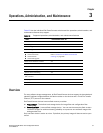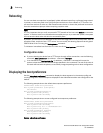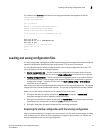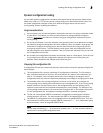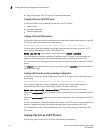
PowerConnect B-Series FCX Configuration Guide 65
53-1002266-01
Loading and saving configuration files
3
The results of the show run command for the configured example above appear as follows.
PowerConnect #show run
Current Configuration:
!
ver 7.2.00aT7f1
!
module 1 FCX-48-port-management-module
module 2 FCX-xfp-2-port-16g-module
module 3 FCX-xfp-2-port-16g-module
!
alias cp=copy tf 10.1.1.1 FCX04000bl.bin pri
!
!
boot sys fl sec
boot sys df 10.1.1.1 FCX04000bl.bin
boot sys fl pri
ip address 10.1.1.4 255.255.255.0
snmp-client 10.1.1.1
!
end
Loading and saving configuration files
For easy configuration management, all Dell PowerConnect devices support both the download and
upload of configuration files between the devices and a TFTP server on the network.
You can upload either the startup configuration file or the running configuration file to the TFTP
server for backup and use in booting the system:
• Startup configuration file – This file contains the configuration information that is currently
saved in flash. To display this file, enter the show configuration command at any CLI prompt.
• Running configuration file – This file contains the configuration active in the system RAM but
not yet saved to flash. These changes could represent a short-term requirement or general
configuration change. To display this file, enter the show running-config or write terminal
command at any CLI prompt.
Each device can have one startup configuration file and one running configuration file. The startup
configuration file is shared by both flash modules. The running configuration file resides in DRAM.
When you load the startup-config file, the CLI parses the file three times.
1. During the first pass, the parser searches for system-max commands. A system-max
command changes the size of statically configured memory.
2. During the second pass, the parser implements the system-max commands if present and also
implements trunk configuration commands (trunk command) if present.
3. During the third pass, the parser implements the remaining commands.
Replacing the startup configuration with the running configuration
After you make configuration changes to the active system, you can save those changes by writing
them to flash memory. When you write configuration changes to flash memory, you replace the
startup configuration with the running configuration.



